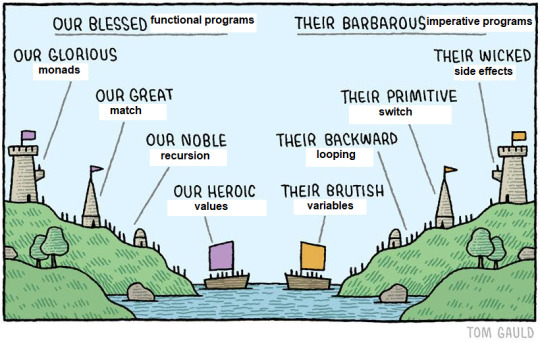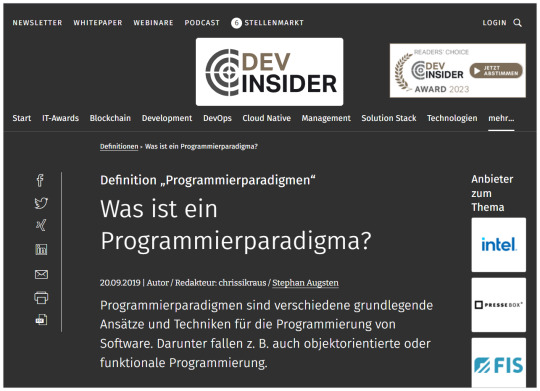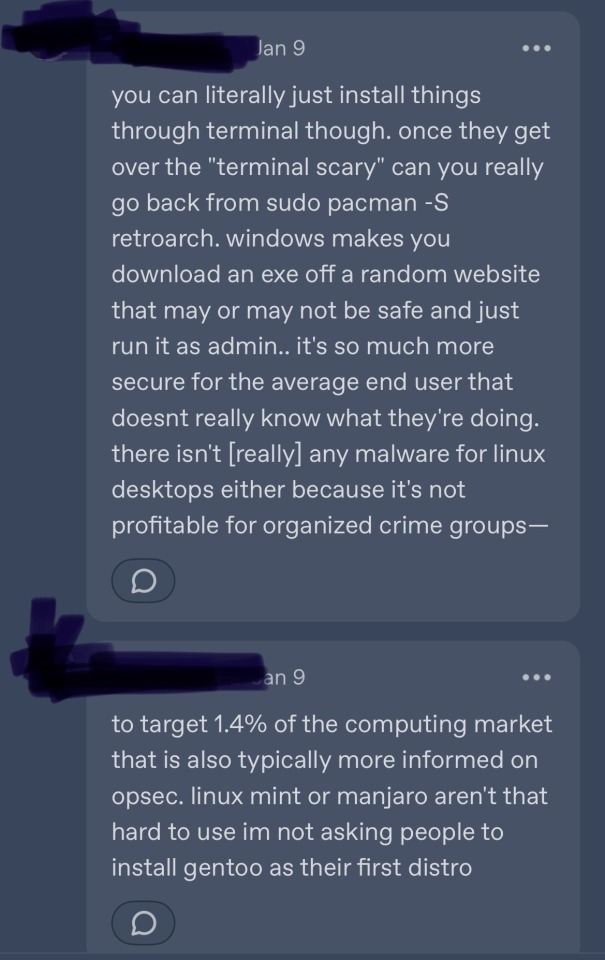#programming paradigm
Explore tagged Tumblr posts
Text
What are you really thinking about programming paradigms?

Source: www.freecodecamp.org
Post #173: FreeCodeCamp, by Germán Cocca, Programming Paradigms, Paradigm Examples For Beginners, May 2022, Buenos Aires, Argentina, 2023.
#coding#programming#small basic#programmieren#microsoft#coding for kids#i love small basic#education#basic programming#basic for ever#programming paradigm#programmier paradigma#paradigma#prardigm
23 notes
·
View notes
Text

#jade talks#got really high last night and couldn't get over the beauty of functional programming paradigms and their mathematical elegance#i would make out sloppy with the lambda calculus if i could
7 notes
·
View notes
Text
well, she's certainly trying her best.....
#SHORB#why is it always such clusterfuck hell to manage state machines#(disregarding the fact that im trying to shove mutable state into a fundamentally immutable programming paradigm)#((dont @ me))#gubdev#gamedev
10 notes
·
View notes
Text


Some shading practice with Halcyon and Paradigm! I'm really digging this style, and I'm definitely learning a lot about the different layer types and what they can do to create these more interesting and dynamic shaded works! Overlay layers are my prized children in these. Mmm, the way they can really sell a glow is so nice.
#Halcyon#Paradigm#transformers#transformers oc#maccadam#my art#Rendering has been really fun lately#Also doing the sketching and lineart in ibispaint then doing coloring in Procreate is SO HELPFUL#I love the brushes for painting in procreate and I love the sketch brushes that I have in ibis#They don't feel the same when used by the other program#Does that make any sense?#I hope so lol#Shading practice#dynamic lighting is something I've been really wanting to work on lol
11 notes
·
View notes
Text
Paradigmen in der Welt der Programmierung ...

www.dev-insider.de/was-ist-ein-programmierparadigma-a-864056/
Behandelte Programmierparadigmen:
strukturierte Programmierung
prozedurale Programmierung
objektorientierte Programmierung
modulare Programmierung
Post #68: DevInsider, Crissi Kraus & Stephan Augsten, Was ist ein Programmierparadigma?, 2023.
#coding#i love coding#programming#coding is fun#education#coding for kids#learning#i love python#i love programming#programming language#python#python coding#paradigma#paradigm#programmiersprache#oop#modular programming#structured programming
4 notes
·
View notes
Link
#Archangels#complementaryopposities#conscious#guidedmeditation#holographicprinciple#hypnosis#imagination#mentalconstructs#mentalpower#paradigm#PersonalTransformation#polarities#self-creation#self-hypnosis#Self-Mastery#self-programming#SpiritualHealing#subconscious#transformation#wholeandpart
0 notes
Text
Types of Programming Paradigms in Python You Should Know
Are you eager to elevate your Python skills and broaden your programming knowledge? Whether you’re looking to deepen your understanding of Python or exploring new ways to approach problem-solving in programming, this blog post is tailored for you. Equip yourself with the knowledge of different programming paradigms in Python and enhance your coding proficiency today! Read the full blog post here.
0 notes
Text
Boosting Interactivity: The Role of Reactive Programming in Modern Apps

Boosting interactivity in modern applications is increasingly reliant on the implementation of reactive programming. Reactive programming is a paradigm that facilitates the seamless handling of asynchronous data streams, fostering a more responsive and dynamic user experience. In today's rapidly evolving technological landscape, where user expectations for real-time interactions are high, reactive programming plays a pivotal role in meeting these demands. By allowing developers to efficiently manage and propagate changes in data, reactive programming enables applications to respond instantly to user inputs, server updates, or any other events that may impact the user interface. This paradigm is particularly beneficial in the development of web and mobile applications, where user engagement heavily depends on smooth and immediate feedback. Through the integration of reactive programming, developers can create applications that not only meet but exceed user expectations, providing a more immersive and satisfying interactive experience. As the demand for responsive and engaging applications continues to rise, the adoption of reactive programming is becoming increasingly prevalent, reshaping the landscape of modern app development.
#reactive programming#reactive frameworks#reactive streams#reactive programming paradigms#reactive systems#reactive programming frameworks
0 notes
Text

#credit:Orion 8#structured programming#structured programming language#software#computer science#structured program#programming#programming paradigms
0 notes
Text
To install software all you need to do is type a string of words you don't unstand to invoke super user privaledges to tell your package manager of choice that's named after a joke a programmer thought was funny (get it, it's pacman like the arcade game!). This will only have open source software that may or may not be up to date depending on how the repository is maintained. This repository does not contain any of the software that a child would want to run such as fortnite, minecraft, minecraft mods and modding tools, etc. It does contain a lot of programming and productivity software that today's computer adverse teens are all CHOMPING at the bit to use.*
This is easier then opening a web browser to Google the website of the software you want to run and clicking the big button that says download, then running the file that pops up in your browser's download feed, or simply clicking yes on the auto run diologue if your browser has that enabled.
*(Like do you realize that the sims modding tools and minecraft server jars and itch.io horror games and ai video upscalers and triple A games that people want to run aren't in those package managers? Like no shit it's gonna be more secure if it's just not capable of installing anything you want to run... Not that the operating system even has compatable binaries made for it in the first place.)

I swear to god computer people talking online about how easy computers/linux are are just that xkcd comic about experts in a field overestimating a layperson’s knowledge (“surely the average person must only know 2-3 feldspars”), over and over again. I felt this firsthand back when I was asking for advice when buying my desktop PC. When a casual computer user reads something like this, at least speaking from personal experience, it is nearly incomprehensible. It is wonderful to want to help the less technologically-fortunate, but you have to break things down more than this. You are speaking wingdings at people.
#I don't get why Linux users think that package managers are easy. Yes they're convinient if you know what you're doing and all the shit you#Want is already on them but if they were actually superior to the executable file paradigm then it would have been adopted by now#If anything package managers are closer to like the app store/ms store in that software has to be approved before it can be listed.#If that's the way you want to get software you can just do it in a graphical window with a search bar that doesn't expect you to already#Know the exact string associated with your desired program#Linux evangelist take a UX course challenge: impossible#You can't have user experience issues if you have no users right?#Sorry for ranting this just makes me so angry in a way I can't quantify#Because normally I'd actually champion Linux but like when I see someone defending something I like poorly and being an presumptuous asshole#About it at the same time it gets me more than someone being outwardly hostile y'know?
798 notes
·
View notes
Text
Object Weenies will take one look at the Rust book, jump straight to Chapter 17 on OOP, and read nothing else. Then they'll be wondering why certain rusty nails can't be struck with the OO hammer.
My brother in Christ, if it takes 17 chapters to get to how to make an object, then there's 16 chapters worth of other ways to solve your problems.
Rust is not an object oriented language. It's not a functional language or a procedural language either. Its paradigm is borrow checker. If you want to generalize, you could say it's an affine type system, but that's a type system rather than a paradigm.
Rust uses whatever paradigm works in the moment. Please let go of your bias towards objects always being the best way.
#rust programming#codeblr#progblr#Borrow checker#OOP#object oriented programming#Me crying and screaming and throwing up that I cant solve every Rust problem with the true superior paradigm of functional programming
0 notes
Text
"Cody Two Bears, a member of the Sioux tribe in North Dakota, founded Indigenized Energy, a native-led energy company with a unique mission — installing solar farms for tribal nations in the United States.
This initiative arises from the historical reliance of Native Americans on the U.S. government for power, a paradigm that is gradually shifting.
The spark for Two Bears' vision ignited during the Standing Rock protests in 2016, where he witnessed the arrest of a fellow protester during efforts to prevent the construction of the Dakota Access Pipeline on sacred tribal land.
Disturbed by the status quo, Two Bears decided to channel his activism into action and create tangible change.
His company, Indigenized Energy, addresses a critical issue faced by many reservations: poverty and lack of access to basic power.
Reservations are among the poorest communities in the country, and in some, like the Navajo Nation, many homes lack electricity.
Even in regions where the land has been exploited for coal and uranium, residents face obstacles to accessing power.
Renewable energy, specifically solar power, is a beacon of hope for tribes seeking to overcome these challenges.
Not only does it present an environmentally sustainable option, but it has become the most cost-effective form of energy globally, thanks in part to incentives like the Inflation Reduction Act of 2022.
Tribal nations can receive tax subsidies of up to 30% for solar and wind farms, along with grants for electrification, climate resiliency, and energy generation.
And Indigenized Energy is not focused solely on installing solar farms — it also emphasizes community empowerment through education and skill development.
In collaboration with organizations like Red Cloud Renewable, efforts are underway to train Indigenous tribal members for jobs in the renewable energy sector.
The program provides free training to individuals, with a focus on solar installation skills.
Graduates, ranging from late teens to late 50s, receive pre-apprenticeship certification, and the organization is planning to launch additional programs to support graduates with career services such as resume building and interview coaching...
The adoption of solar power by Native communities signifies progress toward sustainable development, cultural preservation, and economic self-determination, contributing to a more equitable and environmentally conscious future.
These initiatives are part of a broader movement toward "energy sovereignty," wherein tribes strive to have control over their own power sources.
This movement represents not only an economic opportunity and a source of jobs for these communities but also a means of reclaiming control over their land and resources, signifying a departure from historical exploitation and an embrace of sustainable practices deeply rooted in Indigenous cultures."
-via Good Good Good, December 10, 2023
#indigenous#native americans#first nations#indigenous rights#tribal sovereignty#solar energy#solar power#solar panels#renewable energy#green energy#sioux#sioux nation#sustainability#climate hope#electrification#united states#hope#good news
2K notes
·
View notes
Text
Lose your personality and create a new one
Lose your personality and create a new one because starting over is better than staying stuck with depression, suicidal thoughts or anxiety. We can't emphasize it enough. Today we are born into trauma of some form and at some point we have to end that!
Looking for a goal for 2025? – Lose your personality and create a new one! The mental health and wellness program we created for you to transform your life was initially developed when we encountered people from all over the world, each facing various challenges—whether it was depression, eating disorders, no self esteem, addictions, weight issues, a lack of meaning, or often chronic anxiety…
#addiction recovery centre#anxious personality disorder#creating a new personality#depression and anxiety treatment centre#depression recovery programs#healing the personality#healing trauma and anxiety#mental health and wellness program#mental health south africa#programs for healing anxiety#Psychiatry and psychology#self development#specialised treatment centre#The paradigm Process of healing
0 notes
Text
Post #90: The pillars of object-oriented programming: Object, Class, Inheritance, Polymorphism, Abstraction and Encapsulation, 2023.
The concept of object oriented programming explained
Object-oriented programming is a fundamental concept present in numerous programming languages such as C++, Java, JavaScript, and more. It becomes straightforward once you truly grasp it, and that's precisely what this post aims to help you achieve. So, stop your scrolling for a second and delve into this post for a thorough and clear explanation.

Understanding the Term "Object-Oriented"
To grasp OOP, let's begin by explaining the name itself: "Object-Oriented." This term signifies that OOP revolves around entities known as "objects."
What Exactly Is an Object?
An object in OOP is any entity that possesses both state and behavior. Consider a dog as an example: it has states such as color, name, and breed, while its behaviors encompass actions like wagging the tail, barking, and eating.
The reason we introduce the concept of objects in programming is to effectively represent real-world entities, a task that cannot be accomplished with conventional variables or arrays.
Classes: Abstract Forms of Objects
Now, what about classes? A class is essentially the abstract form of an object. If we take the example of a "dog," the object "Mydog" is a concrete instance, while the class "dog" represents dogs in a more general sense. Think of a class as a blueprint or template from which you can create individual objects.
Four Pillars of Object-Oriented Programming
Now that we've established the fundamentals of objects and classes. OOP is built upon four key principles:
Inheritance: Inheritance occurs when one object inherits all the properties and behaviors of a parent object. It promotes code reusability and facilitates runtime polymorphism.
Polymorphism: Polymorphism entails performing a single task in multiple ways. For instance, it can involve presenting information differently to customers or implementing different shapes like triangles or rectangles.
Abstraction: Abstraction is about concealing internal details while exposing functionality. Consider a phone call; we don't need to understand the intricate inner workings.
Encapsulation: Encapsulation involves bundling code and data into a single unit. Just like a capsule contains various medicines . In a fully encapsulated class (e.g., a Java bean), all data members are private, ensuring data integrity and controlled access.
I remember finding these images that explained these concepts using the 'Squid Game' series, and they are just perfect. So, I'm sharing them here and giving all credit to their owner :
Polymorphism , Inheritance , Encapsulation
#code#python#programming#oop#object oriented programming#class#object#inheritance#polymorphism#encapsulation#abstraction#programmierung#paradigma#paradigm#i love coding#learn python#python coding
44 notes
·
View notes
Link
#Archangels#complementaryopposities#conscious#guidedmeditation#holographicprinciple#hypnosis#imagination#mentalconstructs#mentalpower#paradigm#PersonalTransformation#polarities#self-creation#self-hypnosis#Self-Mastery#self-programming#SpiritualHealing#subconscious#transformation#wholeandpart
0 notes
Note
Is there a story behind China's one child policy that makes it not as horrifying as western media claims?
The defining feature of China's development for the past 70 years has been the urban-rural divide. In order to develop a semi-feudal country with a very low industrial level into an industrialised, socialist nation, it was necessary to develop industrial centres. To 'organically' develop industrial centres would have taken many decades, if not centuries of continued impoverishment and starvation, so programs were put in place to accelerate the development of industry by preferentially supporting cities.
Programs like the 'urban-rural price scissors' placed price controls on agricultural products, which made food affordable for city-dwellers, at the direct expense of reducing the income of rural, agricultural areas. This hits on the heart of the issue - to preferentially develop industrial centres in order to support the rest of the country, the rest of the country must first take up the burden of supporting those centres. Either some get out of poverty *first*, or nobody gets out of poverty at all. The result being: a divide between urban and rural areas in their quality of life and prospects. In order to keep this system from falling apart, several other policies were needed to support it, such as the Hukou system, which controlled immigration within the country. The Hukou system differentiated between rural and urban residents, and restricted immigration to urban areas - because, given the urban-rural divide, everyone would rather just try to move to the cities, leaving the agricultural industry to collapse. The Hukou system (alongside being a piece in many other problems, like the 'one country two systems', etc) prevented this, and prevented the entire thing from collapsing. The 'one child policy' was another system supporting this mode of development. It applied principally to city-dwellers, to prevent the populations of cities expanding beyond the limited size the agricultural regions could support, and generally had no 'punishments' greater than a lack of government child-support, or even a fine, for those who still wanted additional children. Ethnic minorities, and rural residents, were granted additional children, with rural ethnic minorities getting double. It wasn't something anyone would love, but it served an important purpose.
I use the past-tense, here, because these systems have either already been phased out or are in the process of being phased out. The method of urban-rural price scissors as a method of development ran its course, and, ultimately, was exhausted - the negative aspects, of its underdevelopment of rural regions, began to overwhelm its positive aspects. So, it was replaced with the paradigm of 'Reform and Opening Up' around the 1980s. Urban-rural price scissors were removed (leading to protests by urban workers and intellectuals in the late '80s), and the Hukou system, along with the 'one child policy', were and are being slowly eased out as lessening inequality between the urban and rural areas make them unnecessary. Under the new system, the driver of development was no longer at the expense of rural regions, but was carried out through the internal market and external capital. The development paradigm of Reform and Opening Up worked to resolved some contradictions, in the form of the urban-rural divide, and created some of its own, in the form of internal wealth divisions within the cities. Through it, over 800 million people were lifted out of extreme poverty - almost all of them being in rural areas - and extreme poverty was completely abolished within China. 'Extreme poverty' can be a difficult thing for westerners to grasp, wherein poverty means not paying rent on time, but to illustrate - many of the last holdout regions of extreme poverty were originally guerrilla base areas, impassable regions of mountainside which were long hikes away from schools or hospitals, wherein entire villages were living in conditions not dissimilar to their feudal state a century before. These villages were, when possible, given infrastructure and a meaningful local industry accounting their environment and tradition (like growing a certain type of mountainous fruit), or entirely relocated to free government-built housing lower down the mountain that was theirs to own. These were the people the 'one child policy' was aiding, by reducing the urban population they had to support. Again, there were exemptions for rural and ethnic minority populations to the policy.
Even now, Reform and Opening Up is running its course. Its own negative aspects, such as urban wealth inequality, are beginning to overcome its positive aspects. So, the new paradigm is 'Common Prosperity', which will work to resolve the past system's contradictions, and surely introduce its own contradictions in the form of chafing against the national bourgeoisie, as it increases state control and ownership of industry, and furthers a reintroduced collectivisation. Organising a nation of well over a billion people is not simple. It is not done based on soundbytes and on picking apart policies in the abstract for how 'dystopian' they sound. It is an exceedingly complex and interconnected process based on a dialectical, material analysis of things; not a utopian, idealist one. What matters is this: those 800,000,000 people now freed from absolute poverty. The things necessary to achieve that were, unquestionably, good things - because they achieved that. They had their negative aspects, as does everything that exists, but they were unquestionably correct and progressive things.
1K notes
·
View notes